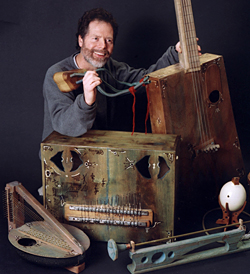
Stephen Wilson’s Information Arts, Intersections of Art Science and Technology is an expansive books that covers many topics, and this essay is devoted to chapter 5, titled “Kinetics, Sound Installations, and Robots”.
Robots in Contemporary Society
In our modern technologically advanced societies, robots have slowly become prevalent. They are mostly invisible; in our transportation systems, computer systems, art, movies and industries. Robots entail many forms, both physical and digital. The rise of these machines raise intriguing cultural questions engaging practitioners from many fields; philosophers, artists, scientists, and technologists.
The Robot Institute of America defines robots as “programmable, multifunctional manipulators designed to move material parts, tools, or specialized devices through variable programmed motions or for the performance of a variety of tasks.”
The world today is filled with many non-robotic machines, using state-of-the-art technology. The chapter details how artists explore the possibilities of these machines with kinetics and experimental sound.
In tandem with Moore’s Law, the development of miniaturized, affordable microcomputers, sensors and actuators have accelerated robot research and development in recent years. Concepts such as intelligence, agency, artificial evolution and communication are being actively developed. Robot construction has also become much more accessible; hobbyist robots have become widely available, encouraging more public interest and experimentation.
The rising popularity of robots resembled the development of early microcomputers. Toys like Capsella and Lego Mindstorm enable children to experiment and construct with sophistication. Robot races and wars attract non-professional tinkerers and wide audiences. Artists and researchers attend hybrid art show/technical meetings like Robotronika; both as presenters and audience.
Conceptual Kinetics and Electronics
‘Art research’ of robotics and machine-based motion have been ongoing amongst artists since the last decades. They share similar agendas with typical technological research; investigating the limits of machine “intelligence”, machine motion agility, artificial life and emergent behavior.
A wide variety of interests were pursued by artists. Some create devices that comment on social issues and machine-human relationships. Others used robots and machine environments to explore the human psyche; similar to artists working in conventional media like painting and sculpture.
These artistic activities highlight the differences in how artists and scientists approach research. Scientists and technologists tend to adhere rigidly to research agendas, while artists chose to explore latent cultural contexts.

Faraday’s Garden 001″ by Perry Hoberman
In early twentieth century, artists pioneered kinetic art to address issues in contemporary culture. At that time, kinetic art was considered radical as paintings and sculptures were deeply prevalent. Conceptual kinetic artists used motors, gears and levers for philosophical and artistic explorations, conceptual investigations and cultural commentary.
Kinetic Instruments, Sound Sculpture
and Industrial Music
Sound artists explored the combination of electricity, recording technology, synthesis, sound editing, radio, and electronics. Modern sound artists utilised tools and materials of industrial technological culture in sound making, creating a myriad of forms integrating the visual and sonic arts. They strived to create new sounds, build alternative instruments, explore sounds of natural vs human-built worlds, create kinetic sculptures and interactive installations.
The human ear offers not just another hole in the body, but a hole in the head. Moreover, the absence of obstructive anatomical features such as earlids would seem to assure a direct and unmediated pathway for acoustic phenomena, with sonic vibrations heading straight into the central nervous system.
– D. Kahn and G. Whitehead, Wireless Imagination (Cambridge, Mass.: MIT Press, 1992), p. ii.

Bart Hopkin
Of special note, instrument-making artists studied materials and physical principles, took risks and experimented to achieve their visions, exemplifying the way artists carry out their research process. Artists dabbling in kinetic sound installations involved complex integrations of research and art as well.
Robots
From the start, robotics has been explored from an artistic angle through a variety of lens, including: theater and dance, autonomy, destruction, social metaphor and robot motion etc.

Robot Wars
Mark Thorpe founded a revolutionary recurring event called Robot Wars. In these competitions, engineers and artists build robots that are pit against one another. Robot Wars can be considered a unique blend of art, technology, sport and theater, highlighting issues of survival and destruction.

Bill Vorn and Louis-Philippe Demers, La Cour des Miracles, 1997
Robots have also been used as a stand-in for commentary on human society.
Louis-Philippe Demers and Bill Vorn’s ‘Scavengers’ installation, filled with robotic devices, allows visitors to directly experience a kind of machine life, society and ecosystem. Deployed in dark hazy spaces, the robots themselves are filled with metaphors of natural societies: parasites, scavengers, overpopulation; a reality filled with “pain” and “sadness”. It aims to induce the viewer’s empathy towards these “beings.”
Conclusion
Is the nature of a robot’s behavior autonomous, responsive, adaptive, organic, adaptable or otherwise? The interplay that occurs between robots and humans is in a state of constant flux.
Robots belong to a new category of objects and situations disruptive to the traditional taxonomy of art.
The chapter has been hugely illuminating, covering a wide gamut of history and knowledge. The evolution and persistent development of robotic applications over the years have been largely due to the availability and cost-effectiveness of components. The Internet has also been instrumental in promoting knowledge sharing over the last few decades. Open source software and hardware, international collaboration over the Internet and rapid globalisation are just some of the underlying factors pushing robotics in media art forward. The lines between art, technology and exploration of the human condition will become increasingly vague, as science and art clash, under the thoughtful hands of media practitioners, researchers and hobbyists.




